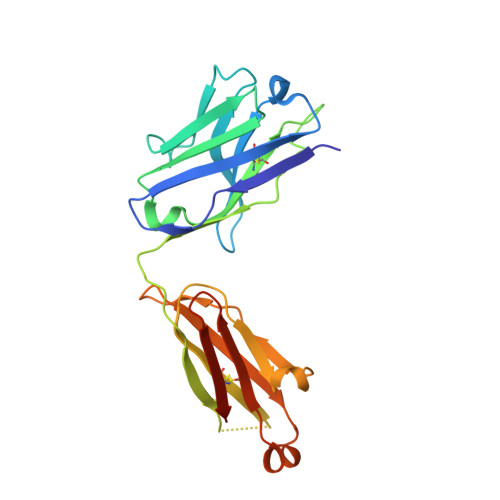CAR T cells based on fully human T cell receptor-mimetic antibodies exhibit potent antitumor activity in vivo.
Salzler, R., DiLillo, D.J., Saotome, K., Bray, K., Mohrs, K., Hwang, H., Cygan, K.J., Shah, D., Rye-Weller, A., Kundu, K., Badithe, A., Zhang, X., Garnova, E., Torres, M., Dhanik, A., Babb, R., Delfino, F.J., Thwaites, C., Dudgeon, D., Moore, M.J., Meagher, T.C., Decker, C.E., Owczarek, T., Gleason, J.A., Yang, X., Suh, D., Lee, W.Y., Welsh, R., MacDonald, D., Hansen, J., Guo, C., Kirshner, J.R., Thurston, G., Huang, T., Franklin, M.C., Yancopoulos, G.D., Lin, J.C., Macdonald, L.E., Murphy, A.J., Chen, G., Olsen, O., Olson, W.C.(2025) Sci Transl Med 17: eado9371-eado9371
- PubMed: 40138458
- DOI: https://doi.org/10.1126/scitranslmed.ado9371
- Primary Citation of Related Structures:
8FJA, 8FJB - PubMed Abstract:
Monoclonal antibody therapies have transformed the lives of patients across a diverse range of diseases. However, antibodies can usually only access extracellular proteins, including the extracellular portions of membrane proteins that are expressed on the cell surface. In contrast, T cell receptors (TCRs) survey the entire cellular proteome when processed and presented as peptides in association with human leukocyte antigen (pHLA complexes). Antibodies that mimic TCRs by recognizing pHLA complexes have the potential to extend the reach of antibodies to this larger pool of targets and provide increased binding affinity and specificity. A major challenge in developing TCR mimetic (TCRm) antibodies is the limited sequence differences between the target pHLA complex relative to the large global repertoire of pHLA complexes. Here, we provide a comprehensive strategy for generating fully human TCRm antibodies across multiple HLA alleles, beginning with pHLA target discovery and validation and culminating in the engineering of TCRm-based chimeric antigen receptor T cells with potent antitumor activity. By incorporating mass spectrometry, bioinformatic predictions, HLA-humanized mice, antibody screening, and cryo-electron microscopy, we have established a pipeline to identify additional pHLA complex-specific antibodies with therapeutic potential.
- Regeneron Pharmaceuticals, 777 Old Saw Mill River Road, Tarrytown, NY 10591, USA.
Organizational Affiliation:




















